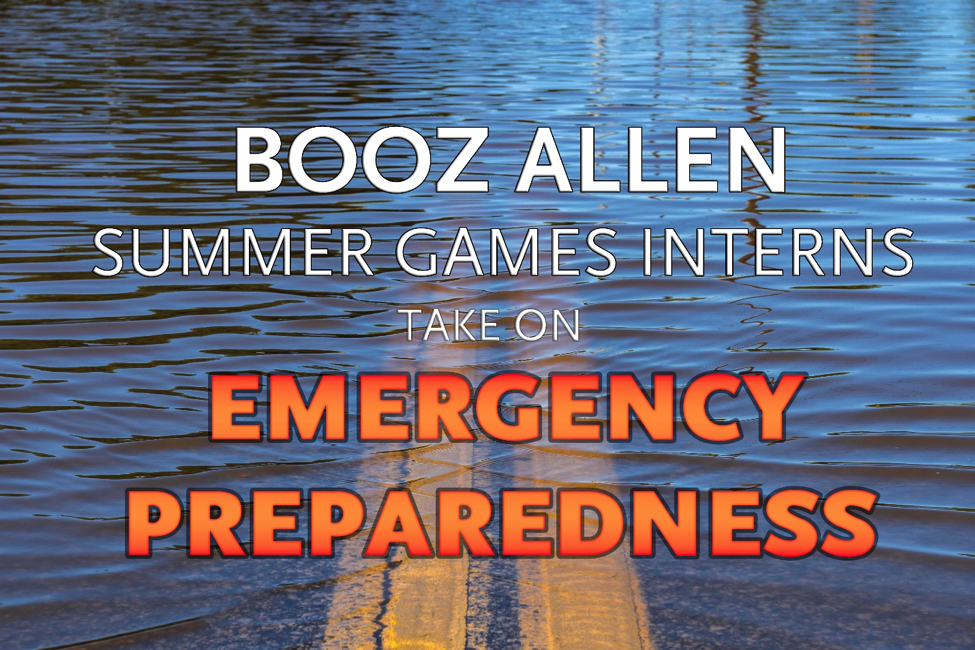Booz Allen Interns Use Crowdsourcing and Smart Phones to Save Lives During Natural Disasters

Natural disasters cost billions in infrastructure repairs and claim tens of thousands of lives each year. In 2016, there were 91 weather, climate or geological disasters in the U.S.—including severe storms, hurricanes, wildfires, earthquakes, heat waves and droughts. Globally, there were 750 disasters in 2016, the highest number in four years.1
This summer, five teams of Booz Allen Summer Games interns are using technology to address some of the biggest challenges around disaster response – from helping evacuate people with functional needs, to pinpointing regions in urgent need for emergency responders, to enabling people to judge the depth of standing water.
Below, read about the teams’ transformative work in their own words:
- Speeding Emergency Care to People with Functional Needs
“The elderly, and people with access or functional needs are often at higher risk than other populations during a disaster situation,” said Hannah Bruening from Booz Allen Summer Games Team Access. “With our Functional Needs Preparedness App, we hope to streamline emergency management and give those with access and functional needs the peace of mind and safety that they deserve during a crisis.” The app can be accessed through a mobile web browser.
- Putting Crowdsourcing to Work for Emergency Responders
“During weather disasters, emergency responders often have limited information about where help is most needed. To tackle this head on, we developed a crowdsourcing app that allows responders to gather information efficiently from the public and execute emergency response where it’s needed most,” said Marisa Machlis from Team CROWD (Crowdsourcing Response Optimization for Weather Disasters).
- Putting Smart Phones to Work: Tracking Populations During Disasters
“When delivering emergency supplies to people in need during a disaster, responders are challenged by a reliance on non-conclusive satellite imagery and slow communication with people on the ground. Our app, IoT SAP, uses existing technologies like phones, Bluetooth devices, RFID and NFC systems to track population movement during an event, enabling responders to know where people and supplies are and where they are going,” said Shane Teig from Team IoT SAP.
- Predicting Where Emergency Relief will be Needed Most
“The U.S. Army Corps of Engineers calls the Mosul Dam in Iraq, ‘The Most Dangerous Dam in the World.’ If a breach occurs, as many as a million and a half people will be at risk. We are working to create an agent-based model which would accurately predict the movement of people in this region and in the event of a breach would cause a city-wide emergency evacuation. Our ultimate goal is to create a distribution network for relief and medical aid that can be quickly and effectively employed in that geography,” said Nick Bodner from Team Most Dangerous Dam.
- Using Phone Cameras to Empower Smart Driving
“More than half of deaths during a flood are vehicle-related—people inaccurately perceive the danger in what they believe is just a few inches of standing water. Our app allows users to visualize street flood levels using their phone camera and an interactive augmented reality display. Our goal is to inspire homeowners to confidently plan for flood events, help homebuyers choose houses that are resilient to a region’s changing landscape, influence drivers to make wiser road travel decisions, and protect entire communities from avoidable tragedy,” said Nicole Woolcock from Rising Waters: Coastal Zone Flood Team.
Want to learn more about the ways Booz Allen Interns are working to solve the world’s toughest challenges? Visit: https://www.boozallen.com/e/careers-content/booz-allen-summer-games.html

